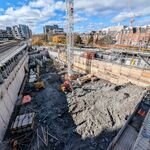dowlingm
Senior Member
Ask Transport Canada. They are concerned with stuff like people not getting mashed when an F40PH and a Flexity hit head on. Silly and boring, I know.I don't understand why we are so stiff in Toronto when it comes to transit. We must have it done with this specific technology and this specific train-set and this specific level of grade separation and this must work the same everywhere this line goes. Where is the creativity in that?
Underwater too, from time to time.Morph the DRL with the Richmond Hill line and call it SmartTrack. The line can be both multi-purpose and all-purpose.
I don't think Hasbro make Transformers transit vehicles, but I'm not omniscient.While we are at it, find a LRT vehicle that can fit the Sheppard tunnel and be used at-grade on Sheppard East.
Yeah, okay.If Bombardier doesn't want to build a vehicle to our specifications than that's their loss, we can take our business elsewhere to a company who gladly will.
You might find this dismissive, but consider that your comments, in particular the first above, are on the far side of the Bell curve on a board not averse to crayoning.




